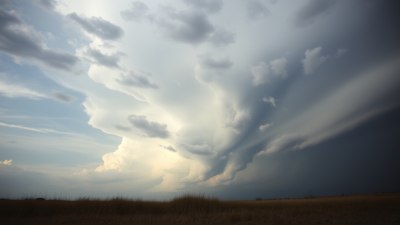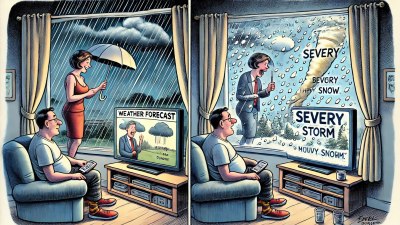What If a Thunderstorm Froze Mid-Air: The Impossible Science Thought Experiment
Explore the fascinating implications of a thunderstorm freezing mid-air in this compelling thought experiment.

Imagining a world where thunderstorms freeze mid-air raises intriguing questions about the nature of atmospheric phenomena and the laws of physics. This thought experiment challenges our understanding of storms, temperature, and state changes of matter. Thunderstorms are typically associated with warm, moist air rising and condensing to form precipitation, but what happens if that process were interrupted by an extreme cold? In the following paragraphs, we will delve into the multifaceted implications of a frozen thunderstorm, exploring its scientific basis, the effects on weather, and the potential consequences for life on Earth.
The Basics of Thunderstorms
Before diving into the thought experiment, it’s essential to understand how thunderstorms operate. Thunderstorms are formed when warm, moist air ascends into the atmosphere, cools, and condenses into clouds. This process releases latent heat, which further fuels the storm. Thunderstorms can produce heavy rainfall, lightning, and even tornadoes. They typically occur in regions with significant temperature gradients and abundant moisture, making them common in tropical and temperate climates.
The Phenomenon of Freezing in the Atmosphere
The freezing of water vapor into ice typically occurs at the top of thunderstorm clouds where temperatures reach below freezing. However, if we imagine a scenario where a thunderstorm were to escalate to such cold temperatures that it freezes mid-air throughout its entire structure, we would encounter a remarkable atmospheric phenomenon.
The Temperature Requirements
For a thunderstorm to freeze mid-air, we would need an environment with temperatures well below the freezing point of water, likely in the range of -20 to -40 degrees Celsius (-4 to -40 degrees Fahrenheit). Such frigid conditions would need to persist long enough to convert the entire volume of water vapor within the storm into ice without the standard processes of condensation and precipitation occurring as expected.
Impacts on Weather Patterns
The immediate implications of a frozen thunderstorm would be drastic. Traditional notions of weather patterns depend on the movement and transformation of both warm air and moisture. A thunderstorm frozen mid-air would disrupt these patterns, potentially leading to severe weather anomalies. For example, if the ice were to break away spontaneously from the storm, it could lead to massive ice falls in the areas below or adversely affect local climate zones.
Potential Effects on Surrounding Ecosystems
The freezing of a thunderstorm could have disastrous effects on ecosystems. Plants and animals are adapted to specific climatic conditions, and a sudden freeze could decimate flora and fauna in the affected regions. For instance, consider the agricultural impact—an ice storm resulting from a frozen thunderstorm could destroy crops, disrupt food supply chains, and lead to famine in severe cases.
The Physical Effects of Ice Particles
The formation of ice particles in the atmosphere would lead to an increase in the size and mass of precipitation. Large ice particles could be more damaging upon impact with the ground, causing destruction to buildings, vehicles, and infrastructure. Furthermore, when these ice particles fall, they can create hazardous conditions for aircraft, risking lives and property.
Gravity and Atmospheric Dynamics
The laws of gravity would still apply, meaning that frozen particles would eventually fall to the ground, but the manner in which they would do so would be far more complex than typical rain. The distribution of these ice particles would not be uniform, leading to highly localized and potentially catastrophic impacts depending on where the ice from the storm lands.
Exploring Climate Change Within Context
In a real-world perspective, the thought experiment of thunderstorms freezing mid-air can lead to discussions on climate change. As global temperatures continue to rise, the dynamics of weather patterns could shift, potentially resulting in unusual phenomena—some of which might come close to this thought experiment. Understanding these scenarios could help meteorologists prepare for unforeseen circumstances in climate-altered futures.
Historical Instances of Sudden Weather Changes
Historically, there have been instances of unusual and extreme weather conditions that came close to our thought experiment. Events like the Great Blizzard of 1888 in the United States or the unexpected snowstorms in unusually warm seasons can provide insights into how drastically weather patterns can change. Observing past anomalies can enlighten our speculative scenario, enriching the discussion surrounding atmospheric science.
Theoretical Models and Simulations
To further analyze a scenario where thunderstorms freeze mid-air, scientists may employ climate models and atmospheric simulations to explore the consequences of such an event. Advanced computational techniques can simulate the formation of ice particles in the atmosphere, observing how they would interact with warm currents and other meteorological factors.
Implications for Future Research
The exploration of such extreme weather events enhances our understanding of atmospheric sciences. Analyzing the consequences of a frozen thunderstorm can shed light on the stability of storm systems, the role of temperature in storm formation, and the science of ice nuclei in precipitation processes. These insights can contribute to better weather forecasting and the development of more resilient infrastructure.
A Philosophical Perspective
Beyond the scientific inquiry, contemplating a world where thunderstorms freeze mid-air invites philosophical considerations of nature’s boundaries. Such a dramatic divergence from the norm challenges our perceptions of reality and our definitions of what is possible within the laws of physics. When can we consider a phenomenon “impossible”? And what does reality mean in the context of extreme weather yielded by changing climates?
While the thought of a thunderstorm freezing mid-air seems far-fetched, pondering its implications leads us to deeper discussions surrounding the nature of weather, the impact of climate change, and the unpredictability of our planet's systems. Through this thought experiment, we can appreciate the complexities of atmospheric science and the fragility of our environment. Understanding these dynamics not only equips us to face possible future scenarios but also heightens our awareness and respect for the forces of nature.











